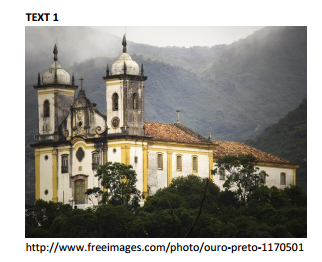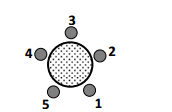Em uma empresa, o diretor de um departamento percebeu que
Pedro, um dos funcionários, tinha cometido alguns erros em seu
trabalho e comentou:
“Pedro está cansado ou desatento.”
A negação lógica dessa afirmação é:

Mining tourism in Ouro Preto
Ouro Preto is surrounded by a rich and varied natural
environment with waterfalls, hiking trails and native vegetation
partially protected as state parks. Parts of these resources are
used for tourism. Paradoxically, this ecosystem contrasts with the
human occupation of the region that produced, after centuries, a
rich history and a cultural connection to mining, its oldest
economic activity which triggered occupation. The region has an
unlimited potential for tourism, especially in specific segments
such as mining heritage tourism, in association or not with the
existing ecotourism market. In fact, in Ouro Preto, tourism,
history, geology and mining are often hard to distinguish; such is
the inter-relationship between these segments.
For centuries, a major problem of mining has been the reuse of
the affected areas. Modern mining projects proposed solutions to
this problem right from the initial stages of operation, which did
not happen until recently. As a result, most quarries and other
old mining areas that do not have an appropriate destination
represent serious environmental problems. Mining tourism
utilizing exhausted mines is a source of employment and income.
Tourism activities may even contribute to the recovery of
degraded areas in various ways, such as reforestation for leisure
purposes, or their transformation into history museums where
aspects of local mining are interpreted.
Minas Gerais, and particularly Ouro Preto, provides the strong
and rich cultural and historical content needed for the
transformation of mining remnants into attractive tourism
products, especially when combined with the existing cultural
tourism of the region. Although mining tourism is explored in
various parts of the world in extremely different social, economic,
cultural and natural contexts, in Brazil it is still not a strategy
readily adopted as an alternative for areas affected by mining
activities.
(Lohmann, G. M.; Flecha, A. C.; Knupp, M. E. C. G.; Liccardo, A.
(2011). Mining tourism in Ouro Preto, Brazil: opportunities and
challenges. In: M. V. Conlin; L. Jolliffe (eds). Mining heritage and
tourism: a global synthesis. New York: Routledge, pp. 194-202.)
The sentence that best explains “Mining tourism utilizing exhausted mines is a source of employment and income.” (l. 18-19) is:
TEXT 3
Sustainable mining – oxymoron or a way of the future?
Mining is an activity that has persisted since the start of humans
using tools. However, one might argue that digging a big hole in
the ground and selling the finite resources that come out of that
hole is not sustainable, especially when the digging involves the
use of other finite resources (i.e. fuels) and produces a lot of
greenhouse gases.
The counter argument could go along the lines that minerals are
not being lost or destroyed through mining and mineral
processing – the elements are being shifted around, and
converted into new forms. Metals can even be extracted from
waste, seawater or even sewage, and recycled. But a more simple
argument is possible: a mine can be sustainable if it is
economically, socially and environmentally beneficial in the short
and long term. To be sustainable, the positive benefits of mining
should outweigh any negative impacts. […]
Social positives are often associated with mines in regional areas,
such as providing better amenities in a nearby town, or providing
employment (an economic and social positive). Social negatives
can also occur, such as dust, noise, traffic and visual amenity.
These are commonly debated and, whilst sometimes
controversial, can be managed with sufficient corporate
commitment, stakeholder engagement, and enough time to work
through the issues. Time is the key parameter - it may take
several years for a respectful process of community input, but as
long as it is possible for social negatives to be outweighed by
social positives, then the project will be socially sustainable.
It is most likely that a mine development will have some
environmental negatives, such as direct impacts on flora and
fauna through clearing of vegetation and habitat within the mine
footprint. Some mines will have impacts which extend beyond
the mine site, such as disruption to groundwater, production of
silt and disposal of waste. Certainly these impacts will need to be
managed throughout the mine life, along with robust
rehabilitation and closure planning. […]
The real turning point will come when mining companies go
beyond environmental compliance to create 'heritage projects'
that can enhance the environmental or social benefits in a
substantial way – by more than the environmental offsets
needed just to make up for the negatives created by the mine. In
order to foster these innovative mining heritage projects we need
to promote 'sustainability assessments' - not just 'environmental
assessments'. This will lead to a more mature appreciation of the
whole system whereby the economic and social factors, as well as
environmental factors, are considered in a holistic manner.
(adapted from https://www.engineersaustralia.org.au/westernaustralia-division/sustainable-mining-oxymoron-or-way-future.
Retrieved on August 10, 2015)
As regards the content of Text 3, analyse the assertions below: I - It is well-known that the resources extracted from mines are endless. II - The social negative impacts of mining may be minimized as time goes by. III - Sustainable assessment has a wider field of action than environmental assessment. IV - There is agreement that negative impacts of mining are restricted to the site. The correct sentences are only:
Abel, Bruno, Caio, Diogo e Elias ocupam, respectivamente, os
bancos 1, 2, 3, 4 e 5, em volta da mesa redonda representada
abaixo.

São feitas então três trocas de lugares: Abel e Bruno trocam de
lugar entre si, em seguida Caio e Elias trocam de lugar entre si e,
finalmente, Diogo e Abel trocam de lugar entre si.
Considere as afirmativas ao final dessas trocas:
• Diogo é o vizinho à direita de Bruno.
• Abel e Bruno permaneceram vizinhos.
• Caio é o vizinho à esquerda de Abel.
• Elias e Abel não são vizinhos.
É/são verdadeira(s ):
Indique, dentre os documentos listados abaixo, o que representa uma espécie documental:
A história dos arquivos está intimamente ligada à história do suporte da informação administrativa. Relacione os principais suportes utilizados com o material do qual ele é feito: I – placas ( ) folhas (vegetal) II – papiro ( ) couro III – pergaminho ( ) argila IV – códices A sequência correta é:
Considere os itens a seguir: I – Jéssica de Andrade Ramos II – Janaína Aguiar Rangel III – Jonas Alencar Rabello IV – Julio de Almeida Reis Junior V – Joel de Alcântara Reis Neto Utilizando-se as regras de alfabetação segundo o método de classificação alfabético, a sequência correta é:
Em um arquivo permanente, o instrumento de pesquisa que proporciona uma visão geral do acervo é:
Os documentos digitais podem ser classificados em estáticos e interativos, e esses últimos em dinâmicos e não dinâmicos. Um exemplo de documento digital interativo não dinâmico seria:
O arquivista, para planejar que tipo de mobiliário deve obter para dispor um acervo de documentos textuais, deve levar em consideração:

